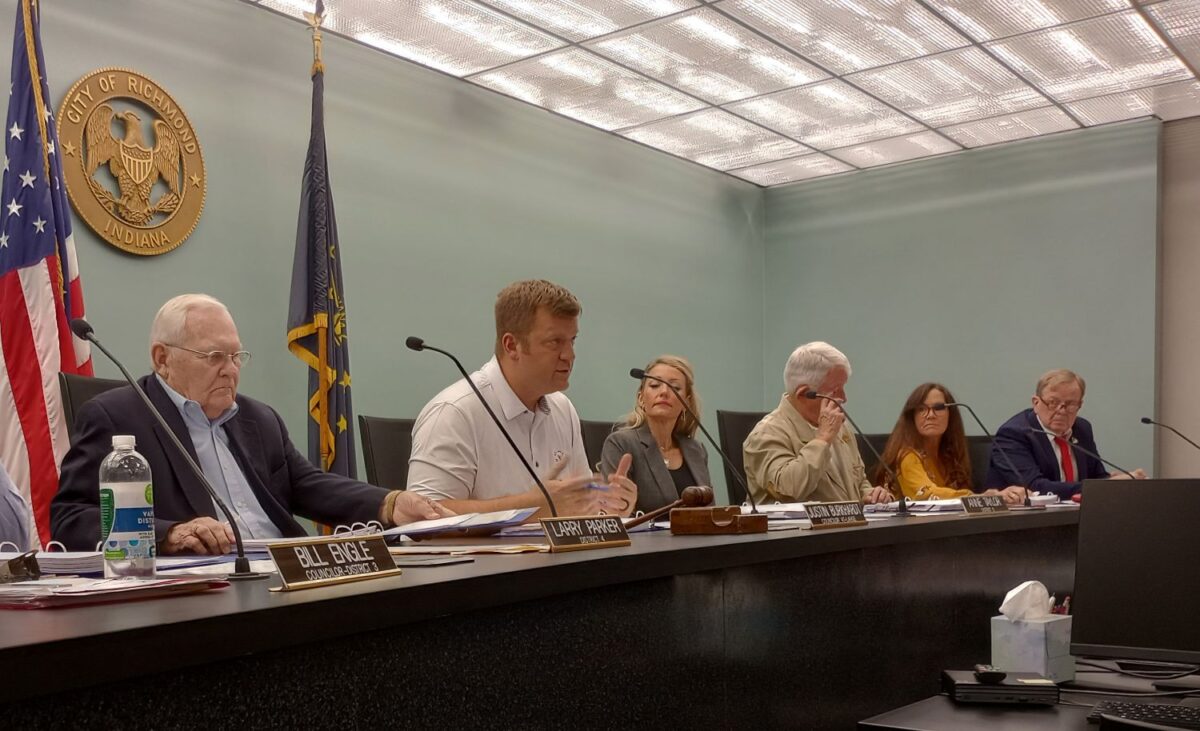Through a painstaking, line-by-line approach, Richmond’s second attempt at a 2026 budget progresses toward financial health and sustainability, but more work remains next year and beyond.
Mayor Ron Oler appointed Beth Fields, the city’s director of strategic initiatives, to lead modification of the proposed budget that originally used unspent 2025 funds to cover a $2.3 million shortfall, a tactic unsatisfactory to some Richmond Common Council members. Council met Oct. 15 in executive session then as its Committee of the Whole to review the more satisfactory revision.
“This was an incredible commitment to getting the city’s finances back on track,” said Justin Burkhardt, who chairs council’s finance committee and specifically thanked Fields and Tracy McGinnis, the city controller, for their efforts. “This is a great first-year attempt at pursuing a balanced budget, living within our means, living in the black. This is something I’m really proud to be a part of.”
Richmond originally advertised a $65 million total budget on the Indiana Department of Local Government Finance website, including more than $27.7 million in the general fund. The new figures on the website, available at wwn.to/richmondbudget26, are $61,499,485 overall and $24,738,254 in the general fund, an overall $3,585,117 savings with a $2,967,982 cut in the general fund.
“Our tasks were to balance our funds, begin to rightsize the operations of city government and ensure our future budgets are sustainable,” Fields said. “This is something that we all acknowledge cannot be done in a single budget year. It will be an ongoing process that will continue during the coming years.”
Only two budget funds — local road and street, and park and recreation — are not balanced for 2026, but they are funded. “A lot of things” were changed to lower the budget, Oler said. The general fund is expected to grow its cash balance by $17,725.61, putting it $594,679.46 in the black. Oler said it’s the “first time that anybody can remember the general fund’s been balanced and in the black.”
Council scheduled a public hearing on the modified budget Oct. 20, and budget adoption is scheduled for a special 7 p.m. Oct. 30 council meeting. Budgets must be adopted by Nov. 3.
During the Oct. 15 meeting, department heads offered little comment as their budgets were reviewed, and few details were provided about how more than $3.5 million was slashed from the budget.
“We can say more on the 30th when it’s adopted,” said Oler, who told council that a hiring freeze for nonessential employees went into effect Oct. 14.
“Rightsizing” departments to strike a balance between employees and their tasks was important, Burkhardt said, adding that over time, and for many reasons, the balance had been lost.
“I think it’s a new normal, and the idea is that there’s no interruption in service,” Burkhardt said. “However, we know that with change comes learning and patience and grace, and I think that this is a long-term play. As with anything, we expect that there will be some difficulties here and there.”
Because the city seeks sustainability — “We don’t want this to be a one-and-done,” Burkhardt said — more work remains to stabilize the city financially for the future. Fields noted that although the city’s population has shrunk and residents expect government to shrink accordingly, the infrastructure, such as roads and sewer systems, remains to serve 50,000 residents.
“Now that we have funded 2025 and balanced as many funds as we could for 2026, we are on track to begin rightsizing the operations of city government,” Fields said. “This is something that will take a lot of study, data analysis, collaboration and thoughtful evaluation of what services, amenities and infrastructure we must — and should — provide to the community and what is the most efficient way for us to provide them.”
A few changes were highlighted during the meeting. Police vehicle purchases were removed from the cumulative capital development fund and replaced by other fire department ($279,000) and police department ($195,500) expenditures that would have been in the general fund.
The modified budget also reflects new revenue forecasts this year that impact cash balances. The local income tax fund was reduced $710,178.55 to reflect how much this year’s revenue will fall short of projections. The parks department’s cash flow was also adjusted to better reflect its actual revenue this year, a $54,104.13 savings on wages and $50,000 that will not be used this year for capital purchases.
Capital purchases greater than $5,000 will follow a new policy during 2026 that provides council more oversight. As such, $1,050,000 was moved into council’s portion of the general fund budget for those purchases.
A resolution will be drafted for capital purchases exceeding $5,000. Council will receive the resolution and an explanation about the proposed purchase to approve or deny it. If council approves, the request will wait in the finance department for a purchase order approved by a department head. A designated council member will then approve the purchase order before it progresses to the purchasing manager and controller for their approvals.
The designated council member will also approve invoices submitted for those capital purchases.
“We heard council’s request to be more connected to the larger purchases and contracts funded with general fund dollars,” Fields said. “This new process will accomplish that while honoring the purchasing and internal controls policies that are already in place.”
A version of this article appeared in the October 22 2025 print edition of the Western Wayne News.

